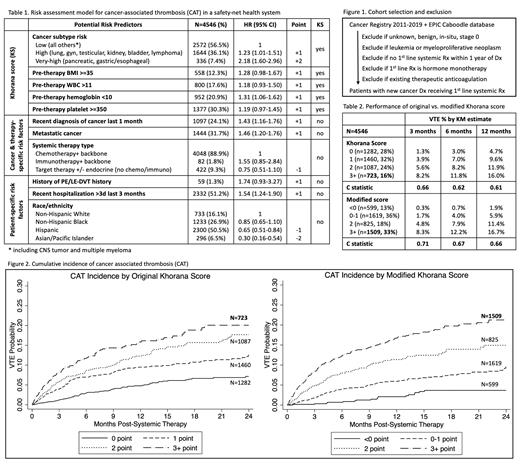Abstract
Introduction: Cancer associated thrombosis is a preventable complication that impacts the quality of life of patients with cancer. The Khorana score (KS) is the most widely used risk assessment model (RAM) to predict venous thromboembolism (VTE) in ambulatory patients undergoing chemotherapy. Potential limitations of the score include modest discrimination and small proportion of patients in the highest risk subgroup. We aimed to examine if a clinical informatics approach incorporating race/ethnicity, cancer staging, type of systemic therapy, and other known VTE risk factors from the electronic health record (EHR) can improve the RAM.
Methods: We performed a retrospective cohort study at Harris Health System (HHS), a safety-net healthcare system that provides care for underserved minorities and uninsured patients in Houston. We created an integrated database that linked consecutive patients with newly diagnosed invasive cancer in the cancer registry with structured data from EPIC Caboodle database 2011-2020. Inclusion/exclusion criteria are shown in Figure 1. We followed patients from time of initial systemic therapy to time of first VTE, death, or loss of follow-up. VTE was defined as radiologically confirmed pulmonary embolism (PE), proximal or distal lower extremity deep vein thrombosis (LE-DVT), catheter-related DVT (CR-DVT), or splanchnic vein thrombosis (SVT) in inpatient or outpatient setting. We used acute, chronic or historical VTE ICD9/ICD10 facility billing codes to assess for potential events and confirmed incident and recurrent events through medical record review. We used multivariable Cox regression to assess potential risk predictors. The model was built iteratively to expand upon the KS. Kaplan Meier failures curves were used to estimate the VTE incidence. C statistic was assessed with binary outcomes at 3- and 6-month.
Results: A total of 4,546 patients with newly diagnosed cancer receiving 1 st line systemic therapy met the inclusion/exclusion criteria. Relevant demographics showed a median age of 54 (IQR 46-61), 57% female, 50% Hispanic, 27% Black, and 75% uninsured. Most common cancer types included breast (17%), colorectal (13%), lung (10%), and non-Hodgkin lymphoma (8%); 32% of patients had metastatic disease. First-line systemic therapy included 89% cytotoxic chemotherapy, 9% small molecule targeted +/- endocrine therapy, and 2% PD-1/PD-L1 immunotherapy. Only 1% had remote VTE history after excluding 317 patients already on therapeutic anticoagulation.
Incident VTE occurred in 477 patients during a median follow-up of 11.3 months. There were 229 PE +/- other, 140 LE-DVT, 94 CR-DVT, and 14 SVT. In addition to the KS covariates (Table 1), recent cancer diagnosis (≤ 1 month) (HR 1.43, 1.16-1.76), metastatic disease (HR 1.46, 1.20-1.76), recent hospitalization (≤ 3 month) (HR 1.54, 1.24-1.90) were also associated with higher risk of VTE, whereas Hispanic ethnicity (HR 0.65, 0.51-0.84) and Asian race (HR 0.30, 0.16-0.54) were associated with a lower risk. Other appreciable predictors included targeted vs. chemotherapy (HR 0.75, 0.51-1.10) and history of PE/LE-DVT (HR 1.74, 0.93-3.27). Immunotherapy (vs. chemotherapy) and black (vs. white) were not associated with VTE.
Figure 2 shows the comparison of VTE incidence using the 2 RAMs. Original KS RAM had c statistic of 0.66 and 0.62 at 3- and 6-month, respectively (Table 2). The highest risk group (3+) included 16% of patients (n=723) and 23% of all VTE (n=108). The modified RAM had better discrimination with c statistic of 0.71 and 0.67 at 3- and 6-month, respectively. The highest risk group (3+) included 33% of patients (n=1509) and 51% of all VTE (n=244).
Conclusions: The KS performed reasonably well in a large safety-net healthcare system with predominantly uninsured patients with advanced cancer initiating systemic therapy. Nonetheless, simple structured data elements from the EHR such as race/ethnicity, staging, therapy type, and recent hospitalization improved the performance of the KS-based RAM and doubled the number of patients in the high-risk stratum and the number of preventable VTE. An integrated clinical informatics approach adapted to the local population can improve outcomes by identifying patients most appropriate for ambulatory thromboprophylaxis.
Carrier: Sanofi: Honoraria; Leo Pharma: Honoraria, Research Funding; Servier: Honoraria; Pfizer: Honoraria, Research Funding; Bayer: Honoraria; BMS: Honoraria, Research Funding.


This feature is available to Subscribers Only
Sign In or Create an Account Close Modal